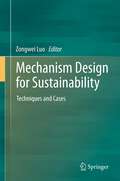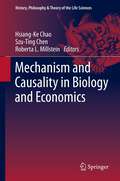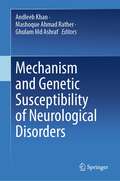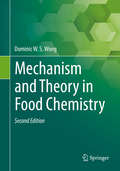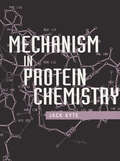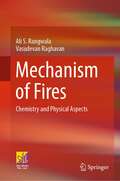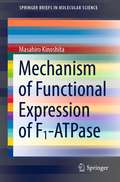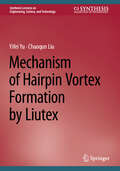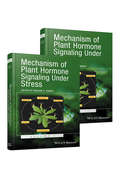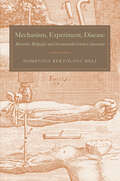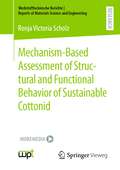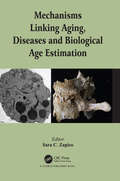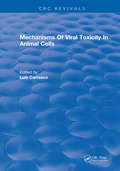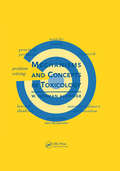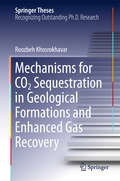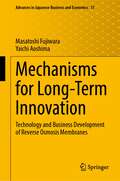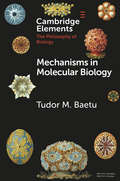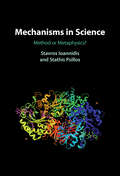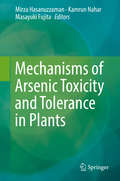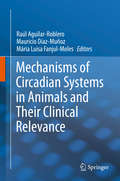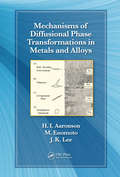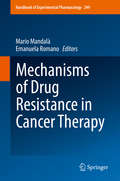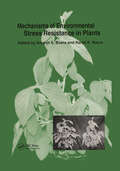- Table View
- List View
Mechanism Design for Sustainability
by Zongwei LuoThis book provides advanced analytics and decision management techniques and tools for developing sustainable competitive advantages in the studied target context. In order to achieve sustainable economy, "the capacity to endure," it is essential to understand and study the mechanisms for interactions and impact from and among these perspectives.
Mechanism and Causality in Biology and Economics
by Szu-Ting Chen Hsiang-Ke Chao Roberta L. MillsteinThis volume addresses fundamental issues in the philosophy of science in the context of two most intriguing fields: biology and economics. Written by authorities and experts in the philosophy of biology and economics, Mechanism and Causality in Biology and Economics provides a structured study of the concepts of mechanism and causality in these disciplines and draws careful juxtapositions between philosophical apparatus and scientific practice. By exploring the issues that are most salient to the contemporary philosophies of biology and economics and by presenting comparative analyses, the book serves as a platform not only for gaining mutual understanding between scientists and philosophers of the life sciences and those of the social sciences, but also for sharing interdisciplinary research that combines both philosophical concepts in both fields. The book begins by defining the concepts of mechanism and causality in biology and economics, respectively. The second and third parts investigate philosophical perspectives of various causal and mechanistic issues in scientific practice in the two fields. These two sections include chapters on causal issues in the theory of evolution; experiments and scientific discovery; representation of causal relations and mechanism by models in economics. The concluding section presents interdisciplinary studies of various topics concerning extrapolation of life sciences and social sciences, including chapters on the philosophical investigation of conjoining biological and economic analyses with, respectively, demography, medicine and sociology.
Mechanism and Genetic Susceptibility of Neurological Disorders
by Ghulam Md Ashraf Andleeb Khan Mashoque Ahmad RatherThis book is about the "Mechanism and Genetic susceptibility of Neurological disorders. It is a comprehensive exploration, penned by esteemed authors, and offers a profound understanding of these enigmatic ailments, their progression, and the strategic approaches employed to mitigate their impact. In this book, readers will uncover a wealth of knowledge surrounding the mechanistic intricacies that underlie various neurological disorders. Through meticulous research and insightful analysis, the authors elucidate the inner workings of these conditions, shedding light on the mechanisms responsible for their onset and progression. The central themes of this book are the recognition of the genetic landscape governing neurological disorders. It emphasizes the role played by a diverse array of genes in the development and progression of these conditions, highlighting the multifaceted genetic susceptibility that underlies their manifestation.
Mechanism and Theory in Food Chemistry, Second Edition
by Dominic W.S. WongFor the first time in over twenty-five years, this unique and popular textbook on food chemistry mechanism and theory has received a full update. Emphasizing the underlying chemical reactions and interactions that occur in foods during processing and storage, this book unifies the themes of "what", "how" and "why" in the language of equations, reactions and mechanisms. This book is the only work which provides in-depth focus on aspects of reaction mechanisms and theories in the chemistry of food and food systems. With more than 500 chemical equations and figures, this book provides unusual clarity and relevance, and fills a significant gap in food chemistry literature. It is a definitive source to consult regarding the important mechanisms that make food components and reactions tick.Mechanism and Theory in Food Chemistry has been a popular resource for students and researchers alike since its publication in 1989. This important new edition contains updates on the original text encompassing a quarter century of advances in food chemistry. Many parts of the original chapters are revised to make for smoother navigation through the subjects, to better explain the underlying chemistry concepts and to fulfill the need of adding topics of emerging importance. New sections on fatty acids, lipid oxidation, meat, milk, soybean and wheat proteins, starch and many more have been incorporated throughout the revision. This updated edition provides an excellent source of all the important chemical mechanisms and theories involved with food science.
Mechanism in Protein Chemistry
by Jack KyteDescribes proteins' physical and chemical nature and how their molecular structures can be determined experimentally. Intended for upper level undergraduate and graduate students with a background in chemistry or biochemistry.
Mechanism of Fires: Chemistry and Physical Aspects
by Ali S. Rangwala Vasudevan RaghavanThis textbook on fire dynamics provides a comprehensive description of fuels involved in fires, definitions related to fire, thermodynamics for fire calculations, basics of transport processes and fundamental aspects of combustion related to fire, physical descriptions of premixed and non-premixed flames, detailed analysis of the characteristics of fires from solid and liquid fuels, including ignition, spread and burning rates and physical aspects of fire plumes, compartment fires and dust fires. The contents also highlight fundamental aspects related to the evaporation of liquid fuels and pyrolysis of solid fuels which are explained with simplified mathematical expressions. The book includes pedagogical features such as worked examples to illustrate mathematical calculations involved in fire analysis and end-of-chapter review questions. This book proves useful for students, researchers and industry professionals alike.
Mechanism of Functional Expression of F1-ATPase (SpringerBriefs in Molecular Science)
by Masahiro KinoshitaThis book presents a new view of the mechanism of functional expression of ATP-driven motors (proteins or protein complexes). It is substantially different from the prevailing idea that the motor converts chemical energy to mechanical work. To facilitate understanding, the differences between the new and prevailing views are explained using many illustrations. The book is of interest to those who are not convinced of the notion of chemo–mechanical coupling. The claims presented are the following: The system, which comprises not only the motor but also water, does no mechanical work during the ATP hydrolysis cycle; a protein is moved or a protein in the complex is rotated by the entropic force generated by water. The highlight of the explanation in the book is that the mechanism of unidirectional rotation of the central shaft in F1-ATPase is discussed in detail on the basis of this new view. The hydration entropy of each β subunit to which a specific chemical compound (ATP, ADP and Pi, Pi, or nothing) is bound, the hydration entropy of the α3β3 complex, and the dependence of the hydration entropy of F1-ATPase on the orientation of the γ subunit play essential roles.
Mechanism of Hairpin Vortex Formation by Liutex (Synthesis Lectures on Engineering, Science, and Technology)
by Chaoqun Liu Yifei YuThis book presents the importance of the mechanism of hairpin vortex formation to understanding flow transition, turbulence, and flow control. This book blends direct numerical simulation (DNS) and mathematical analysis with experiments to create a foundation for understanding turbulence. The authors discuss hairpin vortex as a main component of transitional flow and turbulent flow. In addition, Liutex is utilized and described as a theoretical system that presents valid tools for turbulence research. Readers are exposed to understanding 3D and non-linear instability; the Lambda vortex formation; sweeps, ejections, and shear instability; the Kelvin-Helmholtz instability and vortex ring formation; and turbulence generation and sustenance.
Mechanism of Plant Hormone Signaling under Stress
by Girdhar K. PandeyPlant hormone signaling plays an important role in many physiological and developmental processes including stress response. With the advent of new post-genomic molecular techniques, the potential for increasing our understanding of the impact of hormone signaling on gene expression and adaptive processes has never been higher. Unlocking the molecular underpinnings of these processes shows great promise for the development of new plant biotechnologies and improved crop varieties. The topics included in this book emphasize on genomics and functional genomics aspects, to understand the global and whole genome level changes upon particular stress conditions. With the functional genomics tools, the mechanism of phytohormone signaling and their target genes can be defined in a more systematic manner. The integrated analysis of phytohormone signaling under single or multiple stress conditions may prove exceptional to design stress tolerant crop plants in the field conditions. Bringing together the latest advances, as well as the work being done to apply these findings to plant and crop science, Mechanism of Plant Hormone Signaling Under Stress will prove extremely useful to plant and stress biologists, plant biotechnology researchers, as well as students and teachers.
Mechanism, Experiment, Disease: Marcello Malpighi and Seventeenth-Century Anatomy
by Domenico Bertoloni MeliA leading early modern anatomist and physician, Marcello Malpighi often compared himself to that period’s other great mind—Galileo. Domenico Bertoloni Meli here explores Malpighi’s work and places it in the context of seventeenth-century intellectual life.Malpighi’s interests were wide and varied. As a professor at the University of Bologna, he confirmed William Harvey’s theory of the circulation of blood; published groundbreaking studies of human organs; made important discoveries about the anatomy of silkworms; and examined the properties of plants. He sought to apply his findings to medical practice. By analyzing Malpighi’s work, the author provides novel perspectives not only on the history of anatomy but also on the histories of science, philosophy, and medicine. Through the lens of Malpighi and his work, Bertoloni Meli investigates a range of important themes, from sense perception to the meaning of Galenism in the seventeenth century. Bertoloni Meli contends that to study science and medicine in the seventeenth century one needs to understand how scholars and ideas crossed disciplinary boundaries. He examines Malpighi’s work within this context, describing how anatomical knowledge was achieved and transmitted and how those processes interacted with the experimental and mechanical philosophies, natural history, and medical practice. Malpighi was central in all of these developments, and his work helped redefine the intellectual horizon of the time. Bertoloni Meli’s critical study of this key figure and the works of his contemporaries—including Borelli, Swammerdam, Redi, and Ruysch—opens a wonderful window onto the scientific and medical worlds of the seventeenth century.
Mechanism, Life and Mind in Modern Natural Philosophy (International Archives of the History of Ideas Archives internationales d'histoire des idées #240)
by Charles T. Wolfe Paolo Pecere Antonio ClericuzioThis volume emphasizes the diversity and fruitfulness of early modern mechanism as a program, as a concept, as a model. Mechanistic study of the living body but also of the mind and mental processes are examined in careful historical focus, dealing with figures ranging from the first-rank (Bacon, Descartes, Spinoza, Cudworth, Gassendi, Locke, Leibniz, Kant) to less well-known individuals (Scaliger, Martini) or prominent natural philosophers who have been neglected in recent years (Willis, Steno, etc.). The volume moves from early modern medicine and physiology to late Enlightenment and even early 19th-century psychology, always maintaining a conceptual focus. It is a contribution to a newly active field in the history and philosophy of early modern life science. It is of interest to scholars studying the history of medicine and the development of mechanistic theories.
Mechanism-Based Assessment of Structural and Functional Behavior of Sustainable Cottonid (Werkstofftechnische Berichte │ Reports of Materials Science and Engineering)
by Ronja Victoria ScholzRonja Victoria Scholz assesses the performance of cellulose-based Cottonid for implementation as sustainable construction material. Quasi-static and fatigue tests are performed in varying hygrothermal test conditions using mechanical testing systems in combination with integrable climate chambers. To investigate humidity-driven actuation properties, customized specimen holders are designed. Accompanying microstructural in situ experiments in analytical devices enable a profound understanding of effective material-specific damage and failure mechanisms. The findings are transferred into strength-deformation diagrams as well as Woehler curves, which enable a comparative evaluation of several process-related and environmental influencing factors and can directly be used for dimensioning of Cottonid elements for structural applications. The interpretation of thermoelastic material reponse during loading is used as scientific value for lifetime prediction. Comprehensive investigations on industrial standard materials as well as structurally optimized Cottonid variants provide a scientific basis for categorizing material’s structural and functional performance towards common technical plastics and wood.
Mechanisms Linking Aging, Diseases and Biological Age Estimation
by Sara C. ZapicoThis book focuses on four of the hallmarks of aging: aspartic acid racemization, advanced glycation end products, telomere shortening and mitochondrial mutations; describing their role in aging and diseases; and their application to age-at-death estimation in forensic sciences in greater depth, displaying the interconnecting pathways among these processes. An additional chapter related to Epigenetics and its role in aging, diseases, and forensic age estimation is also included. This book is aimed at a broad audience: from students being introduced to aging, diseases, and forensic science research to scientists in biomedicine and forensics complementing their knowledge in their respective fields while also increasing their knowledge in other disciplines.
Mechanisms Of Viral Toxicity In Animal Cells
by Luis CarrascoThe present book is intended to give an account of the state of the art on how animal viruses induce cytotoxic effects in cells.
Mechanisms and Concepts in Toxicology
by W. Norman AldridgeIllustrating concepts and types of toxicity from a mechanistic point of view, this book focuses on research procedures in toxicology. The book uses examples of chemical intoxicants to illustrate mechanisms in each stage of toxicity.
Mechanisms and Games for Dynamic Spectrum Allocation
by H. Vincent Poor Tansu Alpcan Holger Boche Michael L. Honig Tansu Alpcan Holger Boche Michael L. HonigPresenting state-of-the-art research into methods of wireless spectrum allocation based on game theory and mechanism design, this innovative and comprehensive book provides a strong foundation for the design of future wireless mechanisms and spectrum markets. Prominent researchers showcase a diverse range of novel insights and approaches to the increasing demand for limited spectrum resources, with a consistent emphasis on theoretical methods, analytical results and practical examples. Covering fundamental underlying principles, licensed spectrum sharing, opportunistic spectrum sharing, and wider technical and economic considerations, this singular book will be of interest to academic and industrial researchers, wireless industry practitioners, and regulators interested in the foundations of cutting-edge spectrum management.
Mechanisms for CO2 Sequestration in Geological Formations and Enhanced Gas Recovery
by Roozbeh KhosrokhavarThis book gives background information why shale formations in the world are important both for storage capacity and enhanced gas recovery (EGR). Part of this book investigates the sequestration capacity in geological formations and the mechanisms for the enhanced storage rate of CO2 in an underlying saline aquifer. The growing concern about global warming has increased interest in geological storage of carbon dioxide (CO2). The main mechanism of the enhancement, viz. , the occurrence of gravity fingers, which are the vehicles of enhanced transport in saline aquifers, can be visualized using the Schlieren technique. In addition high pressure experiments confirmed that the storage rate is indeed enhanced in porous media. The book is appropriate for graduate students, researchers and advanced professionals in petroleum and chemical engineering. It provides the interested reader with in-depth insights into the possibilities and challenges of CO2 storage and the EGR prospect.
Mechanisms for Long-Term Innovation: Technology and Business Development of Reverse Osmosis Membranes (Advances in Japanese Business and Economics #31)
by Yaichi Aoshima Masatoshi FujiwaraThis book explores how a long-term innovation can take place based on historical analyses of the development of reverse osmosis (RO) membrane from the early 1950s to the mid-2010s. The RO membrane is a critical material for desalination that is a key to solve water shortages becoming serious in many places of the world. The authors conducted in-depth field studies as well as analyses of rich archival data to demonstrate how researchers, engineers, managers, entrepreneurs, and policymakers interacted each other for this material innovation to be realized. A series of historical analyses in this book uncovered that initial government supports, strategic niche markets, emergence of breakthrough technology, and company-specific rationales played significant roles for companies to overcome four types of uncertainty, technological, market, competition, and social/organizational ones, and enabled the companies to persistently invest in the development and commercialization of the RO membrane. This book depicts that innovation does not arise on a sudden, but that it is actualized through long lasting process with turns and twists, which is driven by many non-economic rationales beyond economic motives.
Mechanisms in Molecular Biology (Elements in the Philosophy of Biology)
by Tudor BaetuThe new mechanistic philosophy is divided into two largely disconnected projects. One deals with a metaphysical inquiry into how mechanisms relate to issues such as causation, capacities and levels of organization, while the other deals with epistemic issues related to the discovery of mechanisms and the intelligibility of mechanistic representations. Tudor Baetu explores and explains these projects, and shows how the gap between them can be bridged. His proposed account is compatible both with the assumptions and practices of experimental design in biological research, and with scientifically accepted interpretations of experimental results.
Mechanisms in Science: Method or Metaphysics?
by Stathis Psillos Stavros IoannidisIn recent years what has come to be called the 'New Mechanism' has emerged as a framework for thinking about the philosophical assumptions underlying many areas of science, especially in sciences such as biology, neuroscience, and psychology. This book offers a fresh look at the role of mechanisms, by situating novel analyses of central philosophical issues related to mechanisms within a rich historical perspective of the concept of mechanism as well as detailed case studies of biological mechanisms (such as apoptosis). It develops a new position, Methodological Mechanism, according to which mechanisms are to be viewed as causal pathways that are theoretically described and are underpinned by networks of difference-making relations. In contrast to metaphysically inflated accounts, this study characterises mechanism as a concept-in-use in science that is deflationary and metaphysically neutral, but still methodologically useful and central to scientific practice.
Mechanisms of Arsenic Toxicity and Tolerance in Plants
by Masayuki Fujita Mirza Hasanuzzaman Kamrun NaharArsenic is likely the most talked-about metalloid in the modern world because of its toxic effects on both animal and plants. Further, arsenic pollution is now producing negative impacts on food security, especially in many south Asian countries. Since plants are a major food source, their adaptation to As-rich environments is essential, as is being informed about recent findings on multifarious aspects of the mechanisms of arsenic toxicity and tolerance in plants. Although numerous research works and review articles have been published in journals, annual reviews and as book chapters, to date there has been no comprehensive book on this topic.This book contains 19 informative chapters on arsenic chemistry, plant uptake, toxicity and tolerance mechanisms, as well as approaches to mitigation. Readers will be introduced to the latest findings on plant responses to arsenic toxicity, various tolerance mechanisms, and remediation techniques. As such, the book offers a timely and valuable resource for a broad audience, including plant scientists, soil scientists, environmental scientists, agronomists, botanists and molecular biologists.
Mechanisms of Circadian Systems in Animals and Their Clinical Relevance
by Raúl Aguilar-Roblero Mauricio Díaz-Muñoz María Luisa Fanjul-MolesWell known experts in the field of Chronobiology from around the world, provide an integrative view of the state of the art of circadian biology. At present, genetic and epigenetic interaction of regulatory pathways among circadian oscillators, metabolic networks, cellular differentiation and neuronal communication are subject of intense scrutiny. The book is organized in three sections: The first includes selected examples of the circadian systems of crustaceans, insects, fish, birds and mammals. The second is a detailed view of the physiological mechanisms underlying the circadian clocks in mammals. Finally, in the third section some examples of the relevance of circadian biology and circadian misalignment to health and disease are provided including nutrition and metabolism, obesity, cancer, cardiovascular and pulmonary diseases, Huntington and affective diseases. This section concludes with a brief review on gene therapy and its potential use as a therapeutic tool to correct "clock genes" pathologies. This book is aimed at all those interested in contemporary aspects of physiology, biochemistry and molecular biology applied to the study and characterization of timing systems. . It could be used as an initial approach to this field, but it also provides updated information for those already familiar with the fascinating field of Chronobiology.
Mechanisms of Diffusional Phase Transformations in Metals and Alloys
by Hubert I. Aaronson Masato Enomoto Jong K. LeeDeveloped by the late metallurgy professor and master experimentalist Hubert I. Aaronson, this collection of lecture notes details the fundamental principles of phase transformations in metals and alloys upon which steel and other metals industries are based. Mechanisms of Diffusional Phase Transformations in Metals and Alloys is devoted to solid-s
Mechanisms of Drug Resistance in Cancer Therapy (Handbook of Experimental Pharmacology #249)
by Mario Mandalà Emanuela RomanoA major objective of this book is to reveal unprecedented opportunities to understand and overcome drug resistance through the clinical assessment of rational therapeutic drug combinations and the use of predictive and prognostic biomarkers to enable patient stratification and tailor treatments. It offers to the readers an updated overview on the possible reasons of failure of new and promising therapeutic opportunities.
Mechanisms of Environmental Stress Resistance in Plants
by Amarjit S. Basra Ranjit K. BasraPlant growth and productivity are limited in many areas of the world by a wide variety of environmental stresses. This book discusses progress made toward the major goal of uncovering the plant resistance mechanisms to biotic and abiotic stresses; the purpose being to utilise this knowledge in genetic modification of plants for achieving improved stress resistance. This volume achieves a new synthesis in considering the mechanisms of resistance at various levels of organisation -- from individual cells and tissues, through whole plants, to communities. Chapters are written by internationally acknowledged experts, who have a wealth of research and teaching experience. With comprehensive and up-to-date coverage, this book analyses many outstanding problems and poses important questions for future research.
